Blade Runner (1982) Review
To celebrate the upcoming release of Blade Runner 2049, we take a look back on Ridley Scott’s original sci-fi classic. Blade Runner 2049 will be hitting theatres the 6th October, directed by the always brilliant Denis Villeneuve and starring Ryan Gosling, Jared Leto and Harrison Ford.
Released : September 9th 1982
Certificate : 15
Director : Ridley Scott
Cast : Harrison Ford, Sean Young, Rutger Hauer, Edward James Olmos, Daryl Hannah, William Sanderson, Joe Turkel
Plot : Set on 2019 earth, robots with near human level of intelligence, called Replicants are used as a work force. When four of the most advanced models escape their work compound a Blade Runner, or Replicant Hunter, is sent to hunt them down.
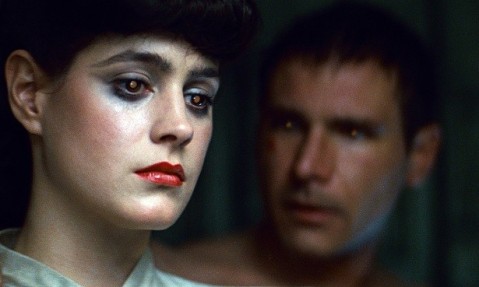 Released just three years after Ridley Scott had cemented himself in the sci-fi genre with Alien in 1979, he returned to the genre for a much more thought provoking tale. While Alien showed how he could masterfully create new worlds with an authentic feel, in Blade Runner he showed how these sci-fi worlds had the capability of deeper meaning and reflection. Not only does the story of Blade Runner bring about deep questions, but literally the architecture of the world Scott create adds to and develops the themes. That’s one of the striking elements of Blade Runner, how the base storyline is a simple as Alien, but the setting, imagery, dialogue and sound all take this plot and help develop it into something more profound.
Released just three years after Ridley Scott had cemented himself in the sci-fi genre with Alien in 1979, he returned to the genre for a much more thought provoking tale. While Alien showed how he could masterfully create new worlds with an authentic feel, in Blade Runner he showed how these sci-fi worlds had the capability of deeper meaning and reflection. Not only does the story of Blade Runner bring about deep questions, but literally the architecture of the world Scott create adds to and develops the themes. That’s one of the striking elements of Blade Runner, how the base storyline is a simple as Alien, but the setting, imagery, dialogue and sound all take this plot and help develop it into something more profound.
To refer to the simply nature of the plot, everything is laid out at the start in text form. Man creates intelligent life as a workforce, some rebelled, humans crush the rebels and ban these life forms from earth. Here the film opens up so many themes such as identity, morality, slavery, colonialism and social structure. Scott then creates a world which reflects these themes. It has been widely discussed how the social structural themes of the Replicants slavery in mirrored by the architecture of the city. The buildings that house the wealthy creators of the Replicants clearly look like a temples fit for a king. The inhabitants of this upper class society are white males and the interiors are all polished and neat, while the city life below it is multi-cultural, gritty and chaotic. A clear commentary on racial and social structure issues. The film is full of imagery such as this. A return to this series is so exciting as it promises a re-emergence of profound imagery that has been missing in the sci-fi genre recently. Denis Villeneuve has brilliantly attempted to bring back this importance of imagery to the genre with Arrival.
Which leads onto other aspects of Blade Runner. In Arrival while the imagery is sprawling and profound, Villeneuve always focuses on the human emotive aspects of the story. For Arrival that is the struggle of motherhood. Blade Runner also never fails to remain focused on the characters and their struggle, despite all of its morality and creationism themes. Blade Runner is a film that uses its simple narrative not only for deeper themes but aptly fleshes out the characters involved. Each main player in the film struggles with their identity, for example we see Harrison Ford’s Deckard identity as a Blade Runner fall apart as he questions the morality of his job. Scott is able to deal with the grand themes and the small personal struggles of the character seamlessly and in an even-handed way. It is the amalgamation of these large ideas and small character struggle which make Blade Runner amazing, and then there is the music.
The score of the film was created by legendary film composer Vangelis, whose work is too great to list. Probably most famous for his Oscar winning score for Chariots of Fire. The score for Blade Runner was created entirely in post-production as Vangelis created the sounds via initial viewing of each image and scene of the film. This layered a second vision onto the film, after Scott had finished, Vangelis applied his own interpretation via the music. The results is stunning and the music is an integral part of the experience. Throughout the film a distant dreamlike sound is created, in which distant echoes and drawn out notes are repeated. This distant the sounds create can be interpreted in many ways, firstly as a dream, or perhaps connoting how despite the futuristic setting many of the themes and issues are familiar to us. As well as this it acts to also reflect the characters emotions with great humanity. Just as Scott did, Vangelis was able to deal with the big themes and the characters equally.
Blade Runner works on so many levels. Visually stunning, rich with character drama and brewing with deeper themes and ideas. It’ll be a joy to return to this world next month, thirty five years after the original was released. The ability to juggle the big themes as well as the characters is something that Denis Villeneuve has proven he can do time and again, and his recent work in Arrival shows he’s more than capable in the sci-fi genre. Other reasons to be excited that the sequel will be treated with respect is the addition of Ryan Gosling and Jared Leto, as well as cinematographer legend Roger Deakins (The Shawshank Redemption, No Country for Old Men), and some of Villeneuve past co-workers such as editor Joe Walker (12 Years a Slave, Arrival) and composer Jóhann Jóhannsson (Sicario, The Theory of Everything).
Verdict : A film worthy of the title of sci-fi classic. A film which visual beauty is matched by its richness of story and imagery.
Verdict : 5/5
Quote : “All those moments will be lost, like tears, in rain.”
It (2017) Review
The Goonies on Elm Street
Released : September 8th 2017
Certificate : 15
Director : Andrés Muschietti
Cast : Jaeden Lieberher, Finn Wolfhard, Sophia Lillis, Jack Dylan Grazer, Wyatt Oleff, Chosen Jacobs, Bill Skarsgård
Plot : Set in the 1980’s in a little town called Derry, a group of six children, who refer to themselves as ‘The Losers’ Club’, are terrorised by a shape-shifting monster called Pennywise ‘The Dancing Clown.
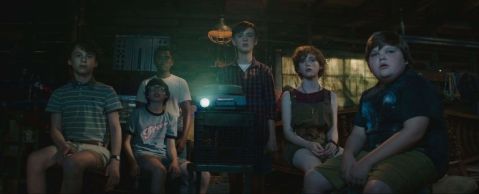 In keeping with the legend of It, twenty seven years on from the original mini-series, we have the return of The Losers’ Club and Pennywise. Directed by Andrés Muschietti whose only previous experience is the moderate successful horror flick Mama, the story of Stephen Kings It has been redone and updated. This film tells the story of what is commonly referred to as Chapter 1, while the book doesn’t make such a clean distinction, in which the characters face Pennywise for the first time as children. An actor yet to become as well-known as his brothers and father, Bill Skarsgård, plays the evil clown.
In keeping with the legend of It, twenty seven years on from the original mini-series, we have the return of The Losers’ Club and Pennywise. Directed by Andrés Muschietti whose only previous experience is the moderate successful horror flick Mama, the story of Stephen Kings It has been redone and updated. This film tells the story of what is commonly referred to as Chapter 1, while the book doesn’t make such a clean distinction, in which the characters face Pennywise for the first time as children. An actor yet to become as well-known as his brothers and father, Bill Skarsgård, plays the evil clown.
As scary as the clown might seem on paper and how horrific the story sounds, this film is far more a horror-adventure rather than a straight up horror. The quest that the children go on to defeat the demon is much more alike The Goonies and Super 8 than any horror flick. The film bleeds the nostalgia for the other 80’s set children adventures, much in the same vain as Stranger Things. This atmosphere and the coming of age aspect of the story brings real warmth to a film that holds no punches when it comes to the darker monster elements. The opening scene of the film is of course the iconic scene from the book and miniseries of Pennywise meeting Georgie while he races his paper boat. From this opening scene it is instantly clear that this is a more brutal and faithful adaption of the source material than the miniseries. Audience that were hoping for clever, suspenseful and inventive scares may be disappointed by the blunt and unrelenting use of ghost and ghouls in this film.
The abundance of monsters is in-keeping with Andrés Muschietti previous film Mama. The horror sequences become so frequent that at times they become slightly trivial, but after a point the quality of the scares and the thrilling pace they add to the film wins you over. With a run time of two hours and fifteen minute’s there is barely a moment to breathe, giving the film a brilliantly relentless pace. Certain set horror pieces, such as a confrontation with Pennywise halfway through, is visually brilliant and really is the stuff of high quality creature-feature work. The CGI that is worked into and around Pennywise is handled very well to create a clown that looks just real enough. But what shines through is how Muschietti deals with the other half of the tale, surrounding the kid’s drama and their development which is the real success of the film.
The cast are across the board good with the standouts of The Losers’ Club being lead Jaeden Lieberher, who is fast becoming a child star, and Stranger Things star Finn Wolfhard who really elevates the film with his comedic talent. As for Bill Skarsgård work, it is as good if not better than Tim Curry’s work with the character. While Curry’s performance was more calm and collected, ironically, Skarsgard makes the character noticeable more manic. The vocals in particular give the character a more unhinged and insane vibe, making him fair less comical and ironic than Curry’s rendition. This is matched well with the CGI decision to have his eyes just off kilter from one another.
It is a million miles better than the miniseries and falls among the better Stephen King adaptions. While the horror aspects are more thrilling and exciting than they are actually unsettling, there are plenty of moments to gasp at. What makes It one of the stronger Stephen King adaptions is that it’s as much about the characters as it is about the monsters. Effective in many areas, from laughter, excitement and character development, this is the better side of mainstream horror films.
Verdict : Both The Losers’ Club and Pennywise are brilliantly brought to life in this fast paced horror adventure which is big on characters and scares.
Verdict : 4/5
Quote : “If you’ll come with me, you’ll float too.”
Top 5 Stephen King Adaptations
To celebrate the release of the new It adaptation, here is our take on the best films to grace the screens based on Stephen King’s work. The miniseries that first adapted King’s tale of The Losers Club is nowhere close to making the cut, with Tim Curry being the only redeeming feature in the three-hour long bore. The films on this list aren’t earning a spot for how faithfully they keep to the source material, but for how they stand alone as great films. So, films that drastically altered elements of King’s work are still contenders. As for hopes for the new It venture, a great King adaptation understands that there are more to his stories than the monsters in them, and attempt to explore the deeper themes of the material. Shockingly out of the following list only one King adaptation has earned an Academy Award.
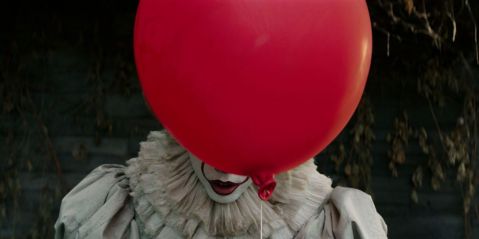
#5 – The Mist (2007)
By no means the best crafted of the Stephen King films or the most thought provoking, but a lot of fun and earns a spot for one key reason, the ending. The climax of the film is much darker than King’s original but is still superb and among some of the most striking climax to any film. The ending only works due to the fact you are invested in the characters by this point. To add to this, it has some great creature features and explores the psychology of the situation well.
#4 – Misery (1990)
At number four, the Oscar winner of the group, as Kathy Bates earned her Best Actress award for a brilliant performance in this film. One of the most memorable King horror films while being the least violent. The film creates tension and character drama beautifully in a very confined set. Directed by Rob Reiner in the middle of a great streak of films including When Harry Met Sally… and The Princess Bride. While Kathy Bates is amazingly unhinged, the work of co-star James Caan shouldn’t be overlooked.
#3 – The Shawshank Redemption (1994)
One of the few works of King to contain no supernatural elements and to be a strip down drama. Few people are aware that this is a King adaptation, a yet it is one of the most celebrated films of all time. It happens to be the highest rated film on IMDB with a score of 9.2/10, lying equal with The Godfather. Why this film above all others is held with such high regard is a mystery. Some reasons that stand out are how it deals with the themes of friendship and hope with such precision and realism.
#2 – The Green Mile (1999)
Breaking into the two films that I believe to be better than ‘the best film of all time’, The Green Mile. Another work of that explores prison life, but here King brings in those supernatural elements. A unique work that many may find too long and sentimental. But the stunning performances across the board, especially from the late Michael Clarke Duncan, and the heart wrenching nature of the film makes it truly memorable. So brutal and moving in parts it’s hard to watch, but worth the pain.
#1 – The Shining (1980)
A conventional choice for first place, as the partnership of the ‘King’ of Horror and one of the masters of cinema, Kubrick, created a true classic. A film that has been studied for years since its release and is mentioned in the same breath as other horror masterpieces such as Psycho and The Exorcists. There is so much here to discuss, but co-screenwriter Diane Johnson summarised the film well, stating when making the film that “It must be plausible, use no cheap tricks, have no holes in the plot, no failures of motivation… it must be completely scary”.
Logan Lucky Review
Back To Basics For Soderbergh
Released : August 25th 2017
Certificate : 12A
Director : Steven Soderbergh
Cast : Channing Tatum, Adam Driver, Daniel Craig, Riley Keough
Plot : Two veteran brothers living in West Virginia, who are locally known to be cursed, fall on hard times. They decided to rob the Charlotte Motor Speedway in North Carolina.

SPOILER WARNING – Review contains allusions to the ending of the film.
After stating four years ago upon the release of Side Effects that he would be retiring from film-making due to the ‘horrific’ way the industry treats directors, Soderbergh returns with another heist comedy. Other complaints that the director had about the industry revolved around how commercially driven the industry has become and how this effected creative freedom. Knowing these facts when watching the film, changes the experience. The way two outsiders try to take on the big corporation, elements of the ending, and the overall quirky creative nature of the film, all makes sense given the directors stated attitudes.
The review tag line which has been most widely circulated is ‘its Coen’s meets Oceans’, and atmospherically it is clear to see why. If a direct film comparison could be made, it would be Barton Fink, due to the way both films are statements about the issues of film making, although Barton Fink does so much more explicitly. Logan Lucky does it as follows. The film isn’t very marketable on paper, the protagonists are unusual and outsiders, the humour isn’t mainstream and is often subtle, and the ending of the film has a definite statement about large corporations and their morality. These features make total sense when you consider Soderbergh complaints about the industry, that it’s become too mainstream, money obsessed, and lacking creativity. So, it appears he made a film that addressed these issues in a very subtle way. To push back in a small way against the film industry, he refuses to use conventional heroic handsome main characters, he doesn’t stay to the ‘accepted’ style of modern comedy, and he ends the film with a middle finger to corporations.
On top of this, the film is distributed by Soderbergh own private company (ensuring creative freedom) and the writer behind the film is a Rebecca Blunt, who is widely believed to be a pseudonym. Enough on the underlying messages of the film, does it function as an entertaining comedy heist. Absolutely. Whoever wrote the film, the script is brilliant. Combining character driven humour and situational comedy and topping it off with a huge amount of deep South American caricatures. Making this a clever and quirky comedy. This style won’t suit all mainstream audiences, as it isn’t as obvious and loud as other comedies out now, such as The Hitman’s Bodyguard. However, there’s definitely enough good laughs here for it to find an audience (or even become a cult hit). As for flaws in the script, the dramatic and emotional tones that come in towards the end aren’t very impactful. Also the overall structure and path of the film isn’t surprising and does stick very much to the Oceans formula.
As for the cast, all actors are relishing the roles very much. Many of the characters are larger than life, and many are clear caricatures. Due to the writing, Adam Driver and Daniel Craig will be the roles remembered from this film, as they are simply given more humour dialogue than Channing Tatum. Having said that, both Driver and Craig are brilliant in this film, being able to be believably portray their eccentric mannerisms and ticks which helps the humour land. These features make this one of the most quotable films recently, for all the right reasons. Seth MacFarlane accent and character can be forgiven. There is also the welcome addition of supporting roles from Hilary Swank and Sebastian Stan.
There’s plenty to really love here. While the film does follow the old Oceans formula very much, it is self-aware in this manner, with a standout line from a reporter in the film being ‘their calling it Oceans 7/11’. With great characters and great laughs this film will have you smiling on the way out of the theatre. Hopefully the success of this film will convince Soderbergh to put off that retirement a little longer.
Verdict : Despite Kermode saying the film is just high quality throw away fun, there are signs here that suggest a deeper meaning about the film industry. A great return for Soderbergh.
Verdict : 4/5
Quote : ‘Did you just say cauliflower to me?’
Manchester by the Sea Review
Another Great Boston Film
Released : January 13th 2017
Certificate : 15
Director : Kenneth Lonergan
Cast : Casey Affleck, Michelle Williams, Kyle Chandler, Lucas Hedges
Plot : Lee Chandler (Affleck), a handy man working in Manchester, has his life turned upside down by the death of his brother (Chandler).
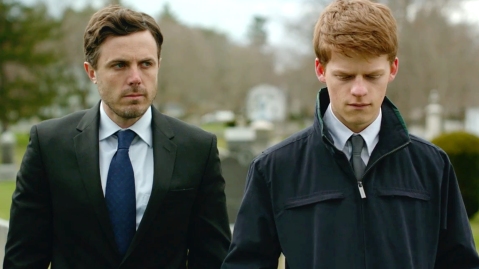 Kenneth Lonergan returns as writer director of one of this year’s Best Picture hopefuls, Manchester by the Sea. Lonergan has proved himself in the Academy’s eyes before, receiving nominations for his screenplays for the little know You Can Count on Me, and the famous Scorsese period gangster film, Gangs of New York. The film stars relative new comer Lucas Hedges has had very smaller roles till now, supporting in films such as The Zero Theorem and Moonrise Kingdom. However has proved to be one of the biggest surprises of the awards season.
Kenneth Lonergan returns as writer director of one of this year’s Best Picture hopefuls, Manchester by the Sea. Lonergan has proved himself in the Academy’s eyes before, receiving nominations for his screenplays for the little know You Can Count on Me, and the famous Scorsese period gangster film, Gangs of New York. The film stars relative new comer Lucas Hedges has had very smaller roles till now, supporting in films such as The Zero Theorem and Moonrise Kingdom. However has proved to be one of the biggest surprises of the awards season.
The story is a pure character drama, with characters which are both relatable and original enough to be engaging. The character, as with many Boston set dramas, may not win the audience over immediately, but ultimately become very memorable cinematic characters. The story arc is masterfully told, allowing for backstory to be tastefully spoon fed into the present events and the creation of several beautiful character arcs. The film is lengthy, and the topic matter sombre and dry in parts, but the script and dialogue so well crafted, that the film is a rare drama that feels authentic and is engaging. The story has such an emotional spectrum, which is executed brilliantly. Amazing humour is sprinkled into the film throughout as a fitting way to keep the film grounded and enjoyable.
To address Lonergan contribution, in this award climate it wouldn’t be surprising if his directing efforts went unrewarded. With the likes of Villeneuve, Gibson and Chazelle dealing with larger than life stories and presenting with such flare and spectacle, the subtle work of Lonergan may be forgotten directorally. But this is a shame as the warmth and heartbreak that Lonergan is able to convey, and perfectly capture character drama, is a gem. If it isn’t cliché to say, from the opening shot, the films presentation has passion and calculation. Lonergan skills as a screenwriter are amazing, building characters and their exchanges which are some of the most engaging and life like this year. Hence making the Screenplay Oscars a coin flip between this and Hell or High Water. Not just the main characters but all supporting casts lines, contribute to the story and represent genuine human traits. Not a throwaway line exists within this film, making it a drama that could be enjoyed for hours.
And to round off the growing merits of the film, the performances are stunning. Casey performance for some, as with the majority of his work, may be viewed as underplayed. But the effect made the character much more lifelike, Lee’s emotions aren’t overplayed, or exaggerated to make the drama more engaging. Instead, much alike the script, the acting is subtle which makes for a more authentic cinematic experience. Lucas Hedges role as well is stunning honest in his acting, bringing to life a tricky character who initially may seem shallow, but develops. Michelle Williams is able to bring so much to the film is so few scenes, absent for probably eighty percent of the film, she is still memorable walking out of the theatre.
Manchester by the Sea is an amazing feat of character drama. Each viewpoint and emotion that is delivered by the script and the acting is understandable and emphatic on some level. It is a film with a subtle current, which ultimately pulls you in. While the story line may be one of the saddest of the award season, this is balanced by the amazing sense of humanity and warmth that the actors and script bring to the film.
Verdict : A few with few flaws. It takes the theme of grief and is able to actualize it with such precision and skill. Plus a heartfelt ending, great humour and amazing performances.
Verdict : 5/5
Quote : “I can’t beat it. I can’t beat it. I’m sorry.”
Split Review (Spoiler Free)
We Need To Talk About Kevin
Released : January 20th 2017
Certificate : 15
Director : M. Night Shyamalan
Cast : Anya Taylor-Joy, James McAvoy, Haley Lu Richardson
Plot : Three girls are abducted after a birthday party. They soon realise that their abductor (McAvoy) suffers from split personality disorder.
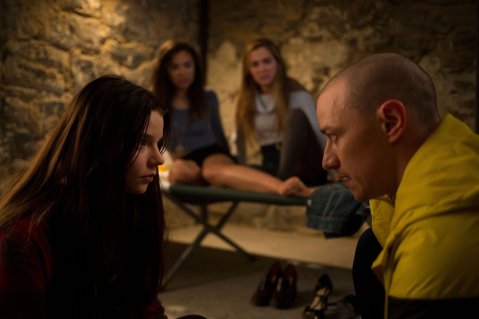
Night Shyamalan, undoubtedly, returns to top form in his new film Split. After four mainstream films, that were poorly received by fans and critics, and other films that aren’t widely known, Shyamalan was considered written off by many. With Split, a film he self-funded as to retain as much creative control as possible, he recruited some brilliant rising horror craftsmen. The cinematographer for the film, Mike Gioulakis, who Shyamalan reportedly wanted to work with instantly after seeing Gioulakis work on It Follows. As well the lead of the film is played by Anya Taylor-Joy, an actress who burst onto the scene with a compelling performance in what is considered 2016 best horror film, The Witch.
Split’s premise alone is an engaging story, with such a quirky psychological concept, it’s a rarity of film making. The premise of the film would make anyone sceptical, unless you have Shyamalan and McAvoy attached to the project. And you can tell from the opening scene that there has been much care taken with the films craft. Firstly, the girls in distress, due to Taylor-Joy character, don’t fit a conventional horror film mould (a side note; it is debatable whether to classify this film as a horror). These characters are smart, and don’t just despair that the situation and have an intriguing dynamic, which was refreshing for the horror genre. Taylor-Joy character is given a backstory that is brilliantly told and bleeds into the rest of the film. The quality of her character and her performance is good enough to match McAvoy going all out in a character with 23 sides. The script deals with McAvoy’s character very well, knowing that humour is required to keep him grounded, and McAvoy’s comedic talent shines in this film.
Of course, being a story told by Shyamalan, there’s a high level of attention that audience will pay to each shot, taking in every detail. Studying the film so much for clues about the narrative, may lead audiences away from the fact, that this is a brilliantly directed film. The shot selection and camera movement screams enigma, keeping you engaged without. It’s not just the storyline that keeps you edgy throughout, Shyamalan has clearly thought through every shot very well, and it’s a joy to see such precise and passionate filmmaking. It is for this reason and the performances, that makes Split so great, because as many other critics have said, the brilliance to this film isn’t confined within the ending.
To talk more on the performances, McAvoy’s role in this film is likely an actor’s dream, and it is one of his best roles yet. A lot rides on his performance, and due to an excellent script by Shyamalan, there character couldn’t have been better realised. There are scenes that in a ‘split’ second, the character change swing from humorous and playful, to eerily sinister. And throughout he remains hugely entertaining. Taylor-Joy’s role in the film, demands slightly less of her than The Witch did, but she’s an actress with a great ability to speak volumes without any dialogue, and really shines as another compelling ‘horror’ character.
Split is a hugely pleasing film, it’s such a joy to see a filmmaker regain their spark after becoming an definitive name of the turn of the millennial. Here he displays just as much skill with script writing as with directing. A script, which has dialogue that both develops character and story excellently and contains an overall narrative that is unpredictable and rich. Directing that is so well crafted, creating sickeningly thrilling set piece of action and drama, and an ability to maintain tension throughout, despite a limited set.
Verdict : Shyamalan is back. Split is hilarious, deliciously dark, unpredictable, poignant and rewatchable. A jaw dropping experience.
Verdict : 5/5
Quote : N/A (As to reveal nothing.)
Hush Netflix Review
Don’t Look Now
Released : March 12th 2016
Certificate : 15
Director : Mike Flanagan
Cast : Kate Siegel, John Gallagher Jr., Michael Trucco, Samantha Sloyan, Emilia Graves
Plot : A deaf writer has moved out of the city into the woods for peace of mind. One night a masked killer shows up at her front door, and a game of cat and mouse ensues.
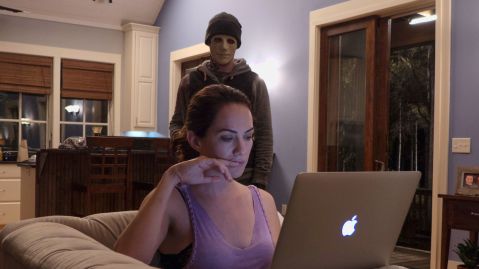 Mike Flanagan goes from strength to strength as a skilled upcoming horror director. Having first broken onto the scene with the critically well received Oculus, a film about a haunted mirror in 2013. Now this year he returns with two motion pictures. Firstly, a sequel to a horror flop Ouija, the sequel titled Ouija: Origin of Evil, which according to Rotten Tomatoes score was superior to Oculus. And now the straight to Netflix film Hush. One quick point to discuss, it could be a point of criticism that the horror film victimises a disability, something that other horror films of 2016 did, most notably Shut In (a film centring around a bedridden, catatonic state boy). Hush in my opinion doesn’t do so as the film is in no way negative in its use of the disability and is purely used as a character trait and a means of developing tension.
Mike Flanagan goes from strength to strength as a skilled upcoming horror director. Having first broken onto the scene with the critically well received Oculus, a film about a haunted mirror in 2013. Now this year he returns with two motion pictures. Firstly, a sequel to a horror flop Ouija, the sequel titled Ouija: Origin of Evil, which according to Rotten Tomatoes score was superior to Oculus. And now the straight to Netflix film Hush. One quick point to discuss, it could be a point of criticism that the horror film victimises a disability, something that other horror films of 2016 did, most notably Shut In (a film centring around a bedridden, catatonic state boy). Hush in my opinion doesn’t do so as the film is in no way negative in its use of the disability and is purely used as a character trait and a means of developing tension.
Flanagan has stood out in his short career as a fresh, and thoughtful horror director, and Hush is no exception. Likely his most thrilling film to date, the film puts a clever spin on the home invasion horror premise. The films scenes leading up to the meet of our hero and villain are mesmerizing and well thought out. The film from then on is a white knuckled thrill ride, that makes it an undiscovered gem on Netflix. While not every aspect of the film revolves around the deafness of the lead character or directly implements it in all her action against our villain, the film is still cunningly clever. The home invasion genre with a twist of the sense was a theme of popular horror films of 2016, with Don’t Breathe being another big success of the year. Having not scene Don’t Breathe, I review Hush with its own rights and merit.
The only real flaws that can be found in the film are that it doesn’t quite revolutionise the home invasion film to a huge degree, as it still follows the basic tropes and conventions. And secondly the villain played by Gallagher Jr was on and off at points. But overall this is an extremely well-crafted thriller. What are surprising aspects about the film, and the key to a good thriller is its ability to evoke real concern for the outcome. Many thrillers, especially the mainstream films of most recent years, fail to generate a real sense of urgency or genuine concern for the lead character(s). Hush does this very well. It is achieved through both Flanagan’s skill and his out of nowhere use of graphic violence that adds brilliantly to the charge of the film.
At a time when so few horror films are up to good quality, and even fewer filmmakers are taking the genre seriously, films like Hush should be celebrated. Granted this isn’t a game changer, and neither are the rest of Flanagan’s films. However, this film alike Oculus, not to spoil anything, shows Flanagan’s ability to play and toy with the narrative at hand, create good thrills without using the generic jump scares or CGI scary faces, and knows where to put the camera to place you right in the moment of the horror.
Verdict : Flanagan has made three horror films, each a success and each a good time, Hush is another superb outing
Verdict : 4/5
Quote : “I can come in anytime I want. And I can get you, anytime I want. But I’m not going to. Not until it’s time.”
Anomalisa DVD Review
(Adult) Toy Story
Released : March 11th 2016
Certificate : 15
Director : Charlie Kaufman, Duke Johnson
Cast : David Thewlis, Jennifer Jason Leigh, Tom Noonan
Plot : A man (Thewlis) who is depressed by the mundanity of his life, finds hope in a chance meeting with a stranger (Jason Leigh).
 Famously wacky none mainstream filmmaker, Charlie Kaufman returns with Anomalisa, a film adaption of his play of the same name. Most famous for his writing ability, with a number of his films being Oscar nominated for their screenplay, including Eternal Sunshine of a Spotless Mind and Being John Malkovich. For this film he ventures in directing as well (this being his most famous director role), along with little known film maker Duke Johnson. Anomalisa gained an Oscar nomination for Best Animated Feature Film.
Famously wacky none mainstream filmmaker, Charlie Kaufman returns with Anomalisa, a film adaption of his play of the same name. Most famous for his writing ability, with a number of his films being Oscar nominated for their screenplay, including Eternal Sunshine of a Spotless Mind and Being John Malkovich. For this film he ventures in directing as well (this being his most famous director role), along with little known film maker Duke Johnson. Anomalisa gained an Oscar nomination for Best Animated Feature Film.
Several imaginative qualities are obvious within the framework of this film. Firstly there is the stop-motion animation work, and as well as this how all but two characters, our leads, are voiced by the same actor, Tom Noonan. This latter feature is obviously a clever way to convey how our lead character, Michael, views everyone as the same and finds no variety or pleasure from his interaction with people. A Guardian article (and others) have suggested, due to this voicing effect, the films dream sequences and how the all the character are animated to look alike (apart from our leads), that Michael suffers from Fregoli delusion. This is a delusion where a person believes everyone else to actually be the same person who changes their appearance. Without further research into Kaufman response or inspiration for the film, I am unaware if this theory carries water. But alike many of the Kaufman’s films, they are so jarring and imaginative in their storytelling, that is seems wrong to attempt to narrow it down to one meaning. If Kaufman’s intention here was to convey messages about the nature of mundanity and depression, instead of the delusion, then these effects are very creative.
The script for the film is much less subtle or effective in this respect of conveying meaning. While not all of his films preach about life’s deeper meanings and the human nature, this film and Eternal Sunshine of a Spotless Mind, do carry these. Unfortunately ‘Eternal Sunshine…’ far surpasses Anomalisa in richness of dialogue and overall script. The overall negativity and pointless conveyed in the dialogue of Michaels character with everyone else is rather ‘obvious’ and unimaginatively done. People in the hallways of the hotel and always swearing or masturbating. As well as this the dialogue of the romance that ensues between Michael and the shy self-conscious Lisa, who he falls for were lacking in panache . While realistic, the scenes weren’t half as moving or gripping as his previous work which so greatly captured people’s spirits.
As for the story as a whole, without spoilers, the film will likely leave the bulk of the audience feeling unfulfilled. Not that a film is obliged to perform this task, and critiquing of a storyline sometimes feels obtuse, due to its very subjective nature, but I too was left dissatisfied. For those who enjoy and respect ending that rebel against a conventional film ending of boy meets girl, then there may be something here for you. But for a film that examines life and human nature, it would have been nice to have an ending that attempted to answer these questions or approach them a little better.
Anomalisa is alike all of Kaufman’s films, beautifully made, with create creativity and flare. This films approach to the topic matter is a bit more generic and less aesthetically surprising than his other films. But it still packs a lot more heart and craft than many other films of last year, just not up to his regular work.
Verdict : One of Kaufmans weaker films. It’s not quite as entertaining or thought provoking as his other works, but is still a heartfelt well-made study of the human condition.
Verdict : 3/5
Quote : “At last! Another person!”
Silence Review
The Last Samaritan
Released : January 1st 2017
Certificate : 15
Director : Martin Scorsese
Cast : Andrew Garfield, Adam Driver, Yōsuke Kubozuka, Tadanobu Asano, Issey Ogata, Liam Neeson
Plot : Two Jesuit priests travel to Japan to find their mentor who apparently has renounced his faith after persecution.

Scorsese follows is most humorous and ludicrous films with his long-desired project Silence, a film that he has desired to make for thirty years now. This being his third film that deals with faith, he re-joins with frequent collaborator Michael Ballhaus and relative newcomer Rodrigo Prieto, both cinematographers, to ensure that if nothing else this biblical epic is one of the best-looking films of the award season. And speaking of awards season, Andrew Garfield stars in Silence, making him a lead role in two of this year’s award tipped films.
Silence is a true epic, in both runtime, semantic scope and technical mastery of its creation. To deal with the second feature, the film obvious deals with the deeper questions of God’s silence, what is means to betray him and general religious philosophy. What was a surprise, was the character drama on show here. While it was to be expected that Garfield and Driver’s character carry the weight of the drama via their character arcs, the supporting casts performance and their scene with our two leads were outstanding. The film contains an abundance of brilliantly scripted set character interaction of brilliant quality. These scenes added much to the film as they developed the character of the oppressed and the oppressors of Japan at the time. This gave a great level of humanity to all the characters allowing for a story much less black and white then; Christianity is goodness and all else is wrong.
Dealing with Scorsese work, for those who appreciate the subtle methods of direction that convey meaning, this is the wrong film. As Scorsese techniques and bold and striking when telling this tale. Initial high bird’s eye view shots create the sense of a God like over watch, and the wide-angle shots of Japan show the immense magnitude of our lead character’s task. Not that these or any other of the shot choices within the film are bad, On the contrary the delivered the story excellently, in the third act a reliance on POV shots from Garfield’s character really build the atmosphere. However, for such as intruding topic and story it was just missing the presentational edge that other Scorsese films had. But when you’re dealing with Scorsese there is always a certain level of excellence, the opening scene one of the most strikingly well shot scenes openings of recent memory.
The opening scene also shows off some of the acting from the well-known trio of actors that star in the film. With Neeson having largely retreated into action roles, it is easy to forget his skill, and he’s actualisation of grief within this film is so real. Grief being a key emotion that all three actors have to deal with, and Garfield does so excellently. Garfield being an actor that can manipulate his voice very well to convey emotions, as for his eyes, which convey so much. Apart from a single over the top scene (on both Garfield and Scorsese part) he is working at the top of his game, and his character tackles with a high magnitude of complex emotions than many other awards contenders.
Silence is not a film that is ‘enjoyed’, due to the gruelling emotional weight, thought provoking nature and graphic scenes. Yet in the same vein of 12 Years a Slave, it is a film that conveys great talent both behind and in front of the camera. Other similarities include character drama that is both intelligent and realistic, and manages to make the audience think.
Verdict : Scorsese may be very forward in how he tells this tale, but that’s a small issue with what is probably the best religious drama of recent years.
Verdict : 4/5
Quote : “I pray but I am lost. Am I just praying to silence?”
- in 2016, 2D, Cinema, films, Genre: sci-fi, Rating: 4/5, Reviewed by: SO, Reviews
- 1 Comment
Arrival Review
Starship Bloopers
Released : November 10th 2016
Certificate : 12
Director : Denis Villeneuve
Cast : Amy Adams, Jeremy Renner, Forest Whitaker, Michael Stuhlbarg
Plot : After 12 UFO’s land across the globe, the US army recruits linguist Louise Banks (Adams) and mathematician Ian Donnelly (Renner) to help communicate with the aliens.
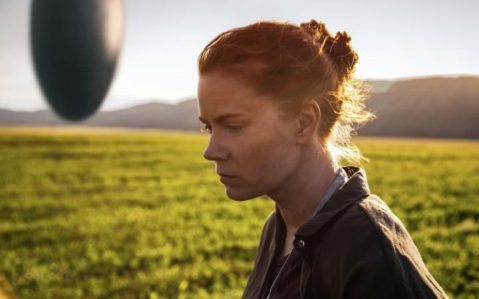
From the screenwriter of the 5th Final Destination film and The Nightmare on Elm Street, ironically comes one of the smartest films of the year. Of course the aspect of the crew that got all cinema goers excited was that of the director. A director renowned for his dark thrillers which drip with brilliant cinematography and calculating presentation. Also ironically, the year the most iconic alien film has a sequel, this film takes the genre in a whole new direction and tone. As we enter the end of the year, this continues the early oscar buzz excitement as the good reviews poor in for the film.
From the screenwriter of the 5th Final Destination film and The Nightmare on Elm Street, ironically comes one of the smartest films of the year. Of course the aspect of the crew that got all cinema goers excited was that of the director. A director renowned for his dark thrillers which drip with brilliant cinematography and calculating presentation. Also ironically, there year the most iconic alien film has a sequel, this film takes the genre in a whole new direction and tone. As we enter the end of the year, this continues the early Oscar buzz excitement as the good reviews poor in for the film.
The story of the film is a brilliant one, and a very new approach to the alien genre, arcing back to Close Encounters territory. Granted only so much credit can be given to the film maker for this aspect, as it is an attempted screenplay. What was really needed to make such a story work was the hand of Villeneuve. A director who was willing to take the time with the story, its complex themes and to avoid as many conventions and clichés in order to realize such a unique approach. Fortunately, these are all features that Villeneuve has displayed throughout his whole work and performs brilliantly here. One feature that Villeneuve is so good at, is building and maintaining an atmosphere that suits the film perfectly throughout his film. The overriding themes that he conveys through the shots in this are that of tremendous spectral, and innocence. All the shot surrounding the aliens are beautiful enough and well thought out enough to make up (mostly) for the lack of ‘action’ that occurs on screen.
Aspects of the film that felt slightly disappointing was the execution of some narrative point. The film centre’s around a single question for the aliens, and thanks to Villeneuve shot that instil and sense of awe, there is the anticipation of a great poignant reveal to this question. The reveal and execution felt slightly rushed, which was surprising, since all other aspects of the film were given such good time to mature. The use of an exposition dump was slightly off. As well as this, the answer wasn’t quiet as smart as the rest of the film annoyingly, such a sense of awe that was built up played off for a rather simple concept. But these issues will be mostly overlooked for many critics and audience members as it is wrapped up in such a brilliant complex and unpredictable plot overall, that a few issues with the climatic acts won’t be much of an issue. The one narrative flaw that some audience might not forgive is that of the pacing, but for most the intellectual drama will be a good enough counterpart for the bullets.
The acting of course as always from Adams is of a very high quality, and she dealt very well under Villeneuve style of heavy reliance of close up of characters. Although it is almost accepted these days, it is worth remembering the skill require to act to nothing, as this film went through probable its share of green screen. One general consensus from many reviews is grips with the character of Jeremy Renner, and a useless of this. While this character doesn’t develop the plot particular, it brings a great level of humanity delivered very well by Renner which was need in the balancing of the tone. The tone of which is unlike any other film that has dealt with aliens, in a film that is overall one of the most unique of the year. While it contains a few flaws, and not quite as much white knuckle excitement as Villeneuve other films, Arrival and very well executed new addition to a genre and will be remembered.
Verdict : Not quite as fulfilling as his other works, due to some small issues. But Villeneuve has brought another very well acted, stunning well shot, thought-provoking film to our screens.
Verdict : 4/5
Quote : “Now that’s a proper introduction.”
Recent Posts
Archives
- September 2017
- February 2017
- January 2017
- November 2016
- October 2016
- September 2016
- June 2016
- April 2016
- March 2016
- February 2016
- January 2016
- December 2015
- November 2015
- October 2015
- September 2015
- August 2015
- July 2015
- June 2015
- May 2015
- April 2015
- March 2015
- February 2015
- January 2015
- December 2014
- November 2014
- October 2014
- September 2014
- August 2014
- July 2014
- June 2014
- May 2014
- April 2014
- March 2014
- February 2014
- January 2014
- December 2013
- November 2013
- October 2013
Categories
- 1961
- 1982
- 1985
- 2010
- 2011
- 2012
- 2013
- 2014
- 2015
- 2016
- 2017
- 2D
- 3D
- Cinema
- Classic Reviews
- Collections
- DVD
- films
- Genre: action
- Genre: animation
- Genre: biopic
- Genre: comedy
- Genre: drama
- Genre: fantasy
- Genre: horror
- Genre: LGBTQ
- Genre: musical
- Genre: period drama
- Genre: sci-fi
- Genre: superheroes
- Genre: thriller
- Genre: western
- Netflix
- Preview Article
- Rating: 1/5
- Rating: 2/5
- Rating: 3/5
- Rating: 4/5
- Rating: 5/5
- Reviewed by: AES
- Reviewed by: SO
- Reviews
- Top 5 List
- Uncategorized
Recent Comments